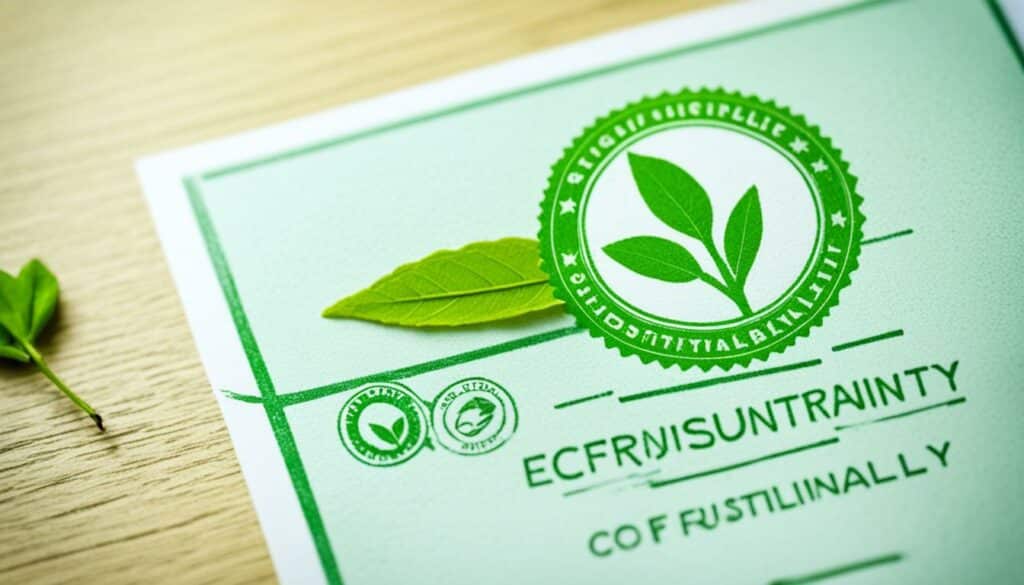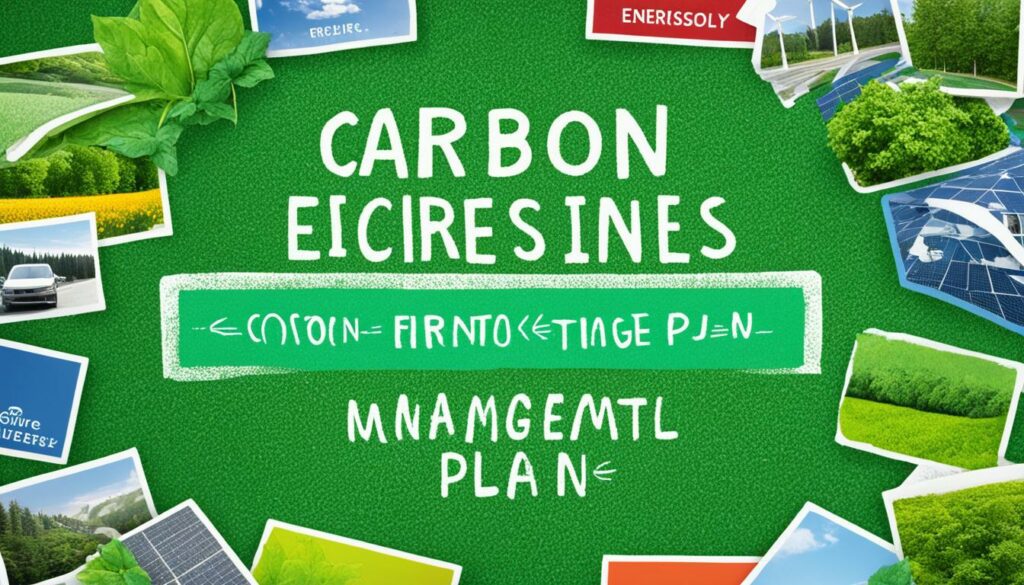Menu

Did you know 70% of consumers are eager to learn what brands do about social and environmental issues now? This big increase shows the need to focus on being sustainable through carbon footprint certification. My path to carbon neutrality has taught me the important steps needed. These steps help lower our environmental impact and meet what consumers expect.
To start this journey towards carbon neutrality, I followed a careful plan. This plan covered checking all types of emissions (like from making products or energy use), creating a strong Carbon Management Plan, and buying credible offsets. Getting certified not only shows we’re serious about being green. It also makes consumers see us in a good light because we care about the environment.
Carbon footprint certification recognises the efforts of organisations, products, or events. They work hard to measure, manage, and cut greenhouse gas emissions. By getting certified, businesses prove they are serious about being green.
Important organisations like the Science-Based Targets Initiative help companies reduce their carbon footprint. There’s a growing need for clear standards to report emissions. Bureau Veritas, for example, has offered the ISO 14064-1 standard from the start. They are experts in checking and verifying carbon reductions.
“The EU Emissions Trading System (EU ETS) is recognised as the world’s first and largest carbon market,”
This system leads the way in using market methods to control emissions.
The ISCC sets out clear rules for getting its Carbon Footprint Certification. It checks emissions from processes, feedstocks, and products. ISCC works to align its methods with well-known standards like ISO 14067. This is to make sure the certifications are reliable.
| Standard/Initiative | Description | Release Date |
|---|---|---|
| ISO 14064-1 | Standard for GHG emissions reporting | Since its inception |
| CORSIA | Emissions verification for international aircraft operators | — |
| ISCC Carbon Footprint Certification | Guidelines for determining GHG emissions | Version 2.3 released twice in March 11 |
ISCC also certifies products with low carbon footprints. This is key in the effort for zero net emissions by 2050.
To sum up, a strong certification process is very important. It shows the world a company is really into being green. It also fits with the worldwide move towards sustainability. This can boost how people see and trust a company.
It’s key for firms wanting to get a carbon footprint certification to know about carbon emissions verification. The process checks GHG emissions in three areas: Scope 1, 2, and 3. This helps fully understand an organisation’s emission levels accurately.

Scope 1 emissions are from sources an organisation owns or controls. This can be from burning fuels in boilers, or from company vehicles and other equipment. Bureau Veritas ensures these direct emissions are right in their checks.
Scope 2 emissions are second-hand, from things like buying electricity or heating. They’re not from the company’s direct operations. These emissions must be correctly measured under standards like ISO 14064-1 and the Greenhouse Gas Protocol.
Scope 3 covers all other indirect emissions via a company’s activities. This includes travel, waste disposal, and even how employees get to work. Though hard to measure, these emissions form the largest part of a company’s total. Companies can lower Scope 3 by supporting green projects and using energy better.
| Scope | Description | Examples |
|---|---|---|
| Scope 1 | Direct emissions from owned or controlled sources | Fuel combustion, company vehicles, chemical production |
| Scope 2 | Indirect emissions from purchased energy | Electricity, steam, heating, cooling |
| Scope 3 | All other indirect emissions within the value chain | Business travel, waste disposal, employee commuting |
Getting the carbon footprint right by following ISO 14067, CORSIA, and Greenhouse Gas Protocol is crucial. It ensures strong verification of carbon emissions. And it helps keep the carbon footprint certification process clear and honest.
Sustainable development accreditation is key for groups wanting to show they care about the planet. It’s more than just an award. It proves that a company really is committed to being green. This makes others, like investors, trust them more.
The Certified B Corporation is a good example. It’s known in 37 US states. It checks how well a company does socially and environmentally. To be certified, you have to follow tough rules, pay a big fee each year, and keep showing how you’re doing.
For the EWG Verified™ stamp, companies have to do a lot online and pay fees yearly. This makes sure the certification stays honest and clear.
There are many kinds of green certifications out there. Forty-six, to be exact, in nine we can think about. They prove you’re serious about going green. For people in green jobs, they may be even more important than usual courses. Groups like ISSP and ACCO offer exams and projects to show what you know.
Fairtrade International and Climate Neutral do a big job. Fairtrade makes sure workers get treated well and paid fairly. Brands that get the FAIRTRADE mark are trusted. Climate Neutral helps companies lower their carbon footprint. This helps fight global warming.
To wrap up, getting a green certification shows you walk the talk. It helps build trust with everyone, from buyers to investors. So, it’s key for any company looking to last and make the world better.
Carrying out an environmental impact assessment (EIA) is vital for firms wishing to grasp and mitigate their environmental impacts. It involves a rigorous exploration, leading to smart choices and better handling of risks.

EIA brings numerous advantages like better decision-making and improved risk handling. It helps firms spot and reduce their impacts on nature, promoting sustainable actions. Moreover, it builds confidence with interested parties and ticks the boxes for obeying rules.
There are various methods for conducting an EIA, all aiming for in-depth analysis. Whether it’s about initial assessments, detailed studies, or ongoing checks, these methods offer a way to understand the environmental impact thoroughly and manage it.
Taking an Environmental Impact Assessment course can provide in-depth knowledge of these methods, ideal for the chemicals and plastics sector. Held at Rotonda Business Club in Cologne, Germany, it’s a three-day event costing 2,160 € and open to many roles. The course is in English, but it offers German-speaking sessions too.
This training mix is hands-on and theoretical, led by experts. It focuses on understanding from a life cycle perspective, enhancing your ability to do studies for your company. There are fun extras like visiting a brewery, to make the learning experience even richer.
| Course Fee | Duration | Location | Number of Participants | Language | Industry Focus | Target Audience |
|---|---|---|---|---|---|---|
| 2,160 € | 3 days | Rotonda Business Club, Cologne | 4-15 | English/German | Chemicals and plastics | Sustainability, Management, R&D, Production, Sales, Procurement, Marketing, IT |
After the course, you get to attend virtual sessions for discussing real-life cases, helping you apply what you’ve learned. Things like the Carbon Footprint Certification (CFC) and ISO 14067 show how EIAs are becoming key for big improvements in green performance.
Checking that a business is sustainable means making sure it acts according to green rules and helps save the planet. Doing this shows everyone that the company really cares about the Earth. The 2021 Climate Awareness report found over 90 percent of people think companies should fight climate change.
According to the Global Sustainability Study 2021, 60 percent of consumers rate sustainability as an important purchase criterion. In the US, this number slightly increases to 61 percent.
Telling people that a business is eco-friendly makes them trust it more. If the company has been checked and confirmed as helping the environment, more than half of shoppers will see the brand in a good light. This is where programmes like the Carbonfree Product Certification come in. Companies go through a detailed review to show they’re really doing good for the planet.
JetBlue managed to become carbon-neutral for all their US flights in 2020. This shows they really mean it when they say they’re green. To do this, they carefully looked at all their flight’s pollution, found ways to make less, and then balanced the rest with green actions.
The Carbon Fund helps other companies get a stamp of approval too. This badge tells customers the product is eco-friendly. It’s important because it can make 60 percent of Americans choose items that are good for the Earth, even if they cost a bit more.
Proving a business is sustainable doesn’t just make people believe in it more. It also makes the company stand out in the market. Even the way to fight climate change can give brands an upper hand.
Checking green credentials is key for companies that care about the environment. It ensures their claims of being eco-friendly are real and clear.

Eco-credentials are more important than ever. Businesses are under the spotlight for their impact on the planet. Showing genuine green efforts boosts a company’s image. For example, sticking to the Carbon Trust Standard or following the EU Emissions Trading Scheme means you’re serious about the environment.
The way green certification happens can vary. But, it always aims to check and confirm eco-friendly actions. For example, checking GHG emissions can be done in different ways depending on where the company is.
| Standard | Verification Frequency | Scope Covered |
|---|---|---|
| California Mandatory GHG Reporting Regulations | Annual, Biennial, Triennial | All GHGs |
| Carbon Trust Standard | Annual, Biennial | All GHGs |
| Earthcheck Certified | Not Specified | Scope 1 & 2 |
| Toitū Envirocare’s carbonreduce | Annual | All GHGs |
| EU Emissions Trading Scheme (EU ETS) | Adheres to Professional Ethics | All GHGs |
Getting a stamp of approval from ISO 14064-1 or CORSIA for airline emissions verification is detailed work. It’s about making sure claims of lower carbon footprints are true. The likes of Swiss Climate CO2 and The World Resources Institute guide best practices in managing greenhouse gases.
PAS 2060 is key for showing a company is serious about being carbon neutral. It was set up by the British Standards Institution in 2010, then updated in 2014. The goal is to guide companies in proving they’re truly carbon neutral. This helps them be clear with their customers.
PAS 2060 tells organisations how to calculate, cut down, and balance their carbon and greenhouse gas emissions. It advises them to use recognised methods like ISO 14064-1. Companies must follow a detailed plan to show they are truly helping the planet. This ensures they back up their environmental claims with solid proof.
As many countries aim for zero net emissions by 2050, things like PAS 2060 have become very important. This certification guide helps companies stand out by showing they are working hard to protect the environment.
There are key steps to reach PAS 2060 compliance:
Claims of carbon neutrality are checked by the organisations themselves, experts, or independent reviewers. This way, everyone is sure the achievement is real and meets all PAS 2060’s tough standards.
Following the PAS 2060 steps not only shows companies are serious about the environment but also makes them stand out as leaders in green practices.
Starting my carbon certification journey was both tough and eye-opening. I realised that by 2030, half of the world’s GHG emissions must be reduced. This fact inspired me to aim for carbon neutrality.

I began by joining programs that back green initiatives. Many companies, like mine, are on the same path. Understanding the Climate Neutral Certification program was key. It focuses on cutting emissions in my supply chain to nearly zero.
Certifying my business was much more than just meeting rules. It was about proving our commitment to sustainability. We followed Business Emissions Evaluator (BEE) to watch our carbon output closely.
Change Climate gave us the tools and knowledge to really make a change. Their guidance helped my team set big climate goals. They also taught us to find real ways to lower our carbon use. This not only made our [certification story](https://www.changeclimate.org/) stronger but taught us a lot about becoming carbon neutral.
I faced many challenges, from tricky data collection to understanding every kind of emission. But sticking to our green goals helped us overcome them. My journey showed me that staying carbon neutral is an ongoing effort. It’s about both personal commitment and professional duty.
Measuring your carbon footprint is key for any business wanting to be more sustainable. It starts with a close look at the emissions you make now. Knowing where these emissions come from helps companies start making real changes.
Looking at emissions means checking everything that releases greenhouse gases into the air. This covers things like your company’s direct actions, the energy it uses, and even how its suppliers contribute. Businesses often use guidelines, such as the Greenhouse Gas Protocol’s breakdown into three scopes, to keep track:
Getting a good grip on how much carbon you’re producing is a first step to cut it down. The UK’s Department for Environment, Food, and Rural Affairs (DEFRA) says following some clear steps is the way to go.
Picking the right way to measure your emissions is crucial for accurate results. Standards, like ISO 14064-1, are there to guide you in detailing and sharing your greenhouse gas data. The Greenhouse Gas Protocol, a joint initiative by the World Resources Institute and the World Business Council for Sustainable Development, is also popular for its thorough framework.
For figuring out the carbon impact of your products or services, you might look to ISO 14067. These methods are trusted to provide clear and reliable reports. They help meet both voluntary and required standards. Plus, getting checked by a respected organisation such as Bureau Veritas shows your company is serious about being green.
| Standard | Description | Application |
|---|---|---|
| ISO 14064-1 | Requirements and guidance for quantifying and reporting greenhouse gas emissions at the organisational level. | Organisational emissions |
| ISO 14067 | Guidelines for quantifying and communicating the carbon footprint of products or services. | Product/service emissions |
| GHG Protocol | Framework for measuring and managing greenhouse gas emissions. | Organisational and value chain emissions |
Using these methodologies helps you not just measure your carbon output but also make plans to lower it. This is crucial for reaching global goals for a greener planet.
Reducing carbon emissions is key for businesses wanting to be more sustainable. They can start by setting goals to lower the amount of emissions produced. This involves understanding types of emissions, like those from their own operations (Scope 1) or those from the energy they buy (Scope 2). Companies can then find out the main sources of their emissions.

It’s vital for companies to set achievable goals to cut emissions. They use data from a year to measure their carbon footprint according to guidelines. Direct emissions from their own places and vehicles (Scope 1) and indirect emissions from energy they purchase (Scope 2) are looked at. Also, emissions linked to their product’s life cycle but not directly controlled (Scope 3) are considered.
To lower emissions, these sources need careful analysis. Then, reduction strategies are put in place. Buying offset credits can help balance out any emissions that can’t be avoided.
A carbon plan is carried out over about 12 weeks, from finding where emissions come from to sharing the results. Setting a clear schedule helps with this. For example, Go Climate Positive has a yearly process to keep emissions in check.
Using structured methods, like those at Go Climate Positive, offers a way forward. Their programs and online support help organisations move towards Net Zero emissions. They can do this gradually through a monthly membership programme.
KPMG notes that carbon dioxide emissions can harm a company’s value. For every 1,000 metric tons of CO2, a company’s worth can drop by $212,000. Therefore, working on a strong carbon management plan is vital for both the environment and a company’s success.
| Certification Levels | Description |
|---|---|
| Carbon Management System | A comprehensive system for managing carbon emissions. |
| Stakeholder Engagement | Involves engaging stakeholders in the carbon reduction process. |
| Net Zero Roadmap | Guides organisations through the transition to Net Zero emissions. |
In summary, creating clear emission-cutting targets and a solid strategy is crucial for a greener future. These steps don’t just help one company. Effective carbon management benefits whole industries.
Public reporting and carbon neutrality documentation are key for clear transparency in reporting. They show we meet global environmental standard compliance. A good structure makes sure we reach sustainability goals in a way everyone can check.
The ISCC Carbon Footprint Certification (CFC) module is being made to help with public reporting. It’s not ready yet, but it’ll be a big help once it is. Pilot audits are testing it to make sure it works right. No certificate will be given without ISCC checking it. Also, you can find all ISCC certificates in their public database for transparency in reporting.
Documents like the ISCC Carbon Footprint Certification (v1.0 was out in March 2024), a large 5.9 MB file, and its update, v1.1, show how detailed our records must be.
Bureau Veritas is really good at checking environmental standard compliance. They’ve been validating against ISO 14064-1 since 2006. They also deal with the EU Emissions Trading System, which is the biggest carbon market worldwide.
For aviation emissions under CORSIA, checking is extremely hard. It’s needed for airlines flying between 117 states. This shows how important and tricky detailed public reports and records are.
“The CFM Standard by Preferred by Nature helps companies measure and lower their GHG emissions to reach carbon neutrality through offsetting,” says its guidelines. This shows how vital it is to have a strong checking process. It looks at climate policies, data, and emissions reduction plans for public reporting.
The checking process can be really broad. It can cover everything from a company’s total emissions to the emissions from their products or services. What’s looked at depends on what the company does and how they want to handle their emissions. Support is there to teach the best ways and initiatives to fight climate change, helping with keeping to strict environmental standard compliance.
The Capacity Building and Support Services are key. They offer classes that cover all aspects of CFM and emissions closely. These learning tools are very important in making sure our carbon neutrality documentation is detailed for reliable public reporting.
Getting a certificate for your carbon footprint has big challenges but also big chances. These need smart plans and actions. The global push for sustainable practices means many companies want these certifications. They’re seen as a necessary part of taking responsibility. Yet, getting there isn’t easy.

One big challenge is collecting all the data for the certificate. It’s most tricky for the things not directly under your control, like emissions from your suppliers. This demands careful checking. Companies also find it hard to keep up with new rules and what customers want. This is tough in sectors where work might move to places with weaker rules, risking more pollution.
But, despite these problems, there are lots of ways to get better and get ahead. Certifications are now tailored to fit different businesses and locations. This makes them more useful and easier to get. For example, big names like DET NORSKE VERITAS, Carbon Trust, and TÜV SÜD offer many types of certificates. These certificates show a company is serious about looking after the environment. They also help companies do better than their competitors.
There are many chances to do better with how we handle our carbon. New technologies, like green energy, are key in cutting our pollution and reaching goals like zero-carbon.
Looking at who’s leading and who’s next big through SWOT analysis is very helpful. It gives companies key information to make smart choices. This look at strengths, weaknesses, chances, and threats in the market helps businesses adjust their plans. This way, they can do better on getting their carbon certificates.
By using these certification chances, companies can set themselves up for success. This fits in with big global efforts, such as the UK wanting to heavily cut carbon by 2035, and China aiming for no more carbon by 2060.
To sum up, the work and money to get a certification are hard but they’re worth it. You get a leg up on your competition, follow the rules better, and look better for your customers.
The impact of certification on sustainability goes beyond helping the environment. It boosts a company’s market performance. Reports show that 41% of how well brands do is because of their purpose. 6,200 companies have become B Corporations to prove they care about sustainability.
Companies with certifications keep more employees and attract new ones. 72% of U.S. workers want to work for companies that share their values. These companies also see their employees less likely to quit and more likely to recommend them.
Customers today care a lot about sustainability. 75% consider this when buying things, says the Boston Consulting Group. Eco-friendly certifications help businesses stand out. They attract customers willing to pay more for sustainable items. Two-thirds of all U.S. consumers and 80% of young adults prefer such products.
By using carbon management and being energy efficient, businesses can cut their bills by a lot. McKinsey & Company highlights the benefits. It not only helps meet environmental rules but also brings tax breaks. This makes their finances stronger.
Deloitte’s report shows companies are spending more on sustainability. Staying efficient with resources helps. It means making smart choices about using resources. This lowers a company’s carbon output and saves money.
Certifications like B Corporations or FSC fight against ‘greenwashing’. In Europe, 42% of green claims were found to be misleading. Strong certifications make companies honest. They help build trust with customers.
In the end, getting certified is great for a business. It’s not just about reducing environmental harm. It helps businesses stand out, attract people who share their values, and keep up with the world’s push for sustainability.
Third-party verification is crucial for the trust and reliability of carbon footprint certifications. It ensures green credentials are dependable, which builds trust. The use of independent verification is widespread and beneficial for many sectors and rules.

Businesses gain a lot from independent verification. It gives a fair review of their GHG emissions. For example, Alberta’s rules demand verification to check compliance effectively.
The trust doesn’t stop there. Carbon Trust’s regular checks keep the certification robust. This solid process is backed by the Canadian Institute of Chartered Accountants. It adds significant value to environmental claims.
In California, verification can be needed every year or every three years. This flexible approach doesn’t weaken the rigorous standards. The global scale of verification is evident with guidelines from Japan and trusted auditors in Spain.
Choosing the right verification body is a smart move. Companies like Toitū Envirocare ensure quality with yearly checks for carbonreduce. Tourism companies aiming for Earthcheck Certified face thorough verifications for a complete view.
ISO 14064-1 and -3 help these service providers deliver top-notch verification. It’s key to pick bodies known and respected in their industry. Matching the verification body with the company’s goals is vital to prove the environmental claims.
Many industries work hard to get carbon footprint certifications. The biotech and pharma sectors are leading this change. They are handling the big issue of reducing their carbon footprints well. Their work shows how different businesses can do the same.
Ben & Jerry’s is a shining example in this endeavour. They took big steps to lessen their environmental impact. Understanding that farms were the main source of their carbon footprint, they acted. They set a long-term goal with Pure Strategies to cut their farm impacts. This goal lined up with the world’s needs to reduce greenhouse gases.
They also set a shorter-term target to cut their greenhouse gas intensity by 20%. This was to happen within six years. They added vegan ice creams to their line. These options have a much smaller environmental impact than dairy products. This move showed their strong push for sustainability.
Pure Strategies even used a special tool, the COMET-farm, to measure emissions from farms accurately. This helped target their efforts better. They plan to do more. This includes working closely with their suppliers, cutting down waste, and focusing on eco-friendly packaging. They are showing everyone that sustainability can be big and successful.
SOLID, a company making stainless steel insulated products, reached carbon neutrality. This was based on the tough ISO 14068-1 standard. SOLID’s efforts were not just about offsetting their carbon. They also invested in a photovoltaic system. This system makes 1.25 million kWh of green electricity every year. Now, over 35% of their power comes from green sources.
SOLID goes further. They ask 70% of their suppliers to track their greenhouse gases. They must also come up with plans to reduce these gases. This approach sets a great standard across industries for getting a carbon certification.
Their product, the “Leyue Bottle”, met high environmental standards and won big awards. The bottle got the German “iF Design Award” and the “Red Dot Award”. These wins show SOLID’s dedication to being eco-friendly and top-quality. They are an excellent example of how success in sustainability can happen in any business.
Carbon footprint certification verifies that organisations, products, or events reduce their greenhouse gas emissions. It confirms their dedication to the environment. This makes their business practices sustainable and friendly to our planet.
Scope 1 emissions come from a company’s own sources. Scope 2 emissions happen from the energy they buy. Scope 3 emissions are all other indirect emissions in the company’s chain. They all must be accurately checked for certification.
Getting accredited for sustainable development shows a company’s real care for the earth. It betters the company’s image and trust with everyone by proving they’re making a true effort for the planet.
Environmental Impact Assessments let businesses see how their work affects nature. They help companies make better choices and lower their risks by carefully checking what impact they have on our environment.
To prove business practices are eco-friendly, they must meet certain standards. This check examines if a company does good for the environment. Then it confirms they keep up with known green guidelines.
Green credentials need to be checked so they’re true. This check makes sure companies really are making the right choices for our planet. It confirms to others that their efforts are real and meaningful.
PAS 2060 guides companies in becoming carbon neutral. It lays out a plan, from measuring emissions to using verified carbon credits to balance their impact on the environment.
First, a company must measure its current emissions. It’s important to use a trusted method to get accurate results. This helps companies know where they stand in terms of their impact.
Having a good plan means setting big, but doable, goals to reduce emissions. It also means setting up a way to reach those goals. This might include getting carbon offset credits if needed.
Publicly sharing reports and documents shows the company is following the right environmental rules. This openness makes their efforts clear and trusted by all those interested.
The path to certification is not easy, dealing with lots of data and tricky emissions to count. But, it also offers a chance to get better and to find new ways to manage carbon well.
Getting this certification means a lot for a business. It helps the environment, improves how people see your brand, and keeps you in line with worldwide efforts to be more green.
Having a neutral party check off on your efforts brings real trust and value. A good verifier gives a fair and independent view, which makes your green efforts more credible.